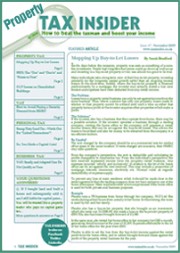Before you go, sign up to our free tax saving email course. Get 7 top property tax saving strategies in your email inbox that will help you save thousands in tax. Unsubscribe any time.
 Tax changes contained in the Finance Act 2006 effectively brought an era of lifetime capital tax planning to an end, and what is left cannot be sure to remain in place. Despite the tax charges levied on ‘Mainstream’/ discretionary trusts (as described in last months’ article) there are still tax planning opportunities to be had. Which is best will depend upon the assets in the estate and cannot necessarily be used to reduce the IHT on an estate with property. The following is a basic outline of some planning opportunities that remain. Tax changes contained in the Finance Act 2006 effectively brought an era of lifetime capital tax planning to an end, and what is left cannot be sure to remain in place. Despite the tax charges levied on ‘Mainstream’/ discretionary trusts (as described in last months’ article) there are still tax planning opportunities to be had. Which is best will depend upon the assets in the estate and cannot necessarily be used to reduce the IHT on an estate with property. The following is a basic outline of some planning opportunities that remain.
Remember: the arrangements covered should not be entered into without first consulting with a suitably qualified and experienced adviser.
Loan Trusts
• Individuals who wish to reduce the future growth of their estate, not adding to the IHT liability but who do not wish to gift the capital as yet.
• An interest-free loan of the capital amount is then made to the trust - repayable on demand. Being a loan rather than an outright gift there will be no potential IHT charge. Unfortunately, the loan can only be of cash and not of any other assets because the capital is invested into an insurance bond written in trust for chosen beneficiaries.
Discounted Gift Trusts (DGT) DGTs are another variation of the NRB discretionary trust such that the capital/cash investment is deemed to be a gift again invested into an insurance bond for chosen beneficiaries with a fixed amount of income drawdown. This time the trust allows the settlor to retain income from a portion of the capital and to gift the remaining portion, the latter portion becoming free of IHT after seven years as it is a gift. Keep the gift to below the NRB and there will be no tax charge on the transfer into the trust.
Situations where the estate needs to be reduced immediately to below the IHT limit but a regular income is required.
• A ‘Mainstream’ trust is created with a lump sum.
Which is best?
‘Charge’ trusts The ’Charge’ route is a yet another variation of the ’loan’ scheme by which the trustees are given the power to accept a charge in satisfaction of the legacy secured on the assets contained in the residue of the estate - which could, this time, include the deceased’s share in a property. There is no cash involved, nor purchase of any bonds. The surviving spouse will normally have no personal liability for the charge, which can be index-linked to take into account future increases in the NRB. Alternatively, the charge can be expressed as a proportion of the value of the house calculated periodically thereby benefiting from any capital appreciation, or it could be made to track a publicly available index of house prices for comparable properties. Once again, on the death of the surviving spouse IHT will be payable but reduced by the charge and if calculated correctly, to below the NRB.
• The surviving spouse is able to continue in occupation of the house as it has been left to him/her absolutely.
The choice of trust, or indeed combination of trusts, is usually influenced by age, income requirements and the need for access to capital. Broadly speaking, the older the life and greater the need for income the DGT is normally more appropriate. Conversely, the younger the life, where more importance is placed on access to capital and without any specific income requirement, the greater the attraction of a loan trust. Finally, it should be remembered that where the priority is to remove the asset from the estate relatively quickly, a business property relief investment is likely to be the most effective solution. This is a sample article from the monthly Property Tax Insider magazine. Go here to get your first free issue of Property Tax Insider. |


 Tax Articles
Tax Articles